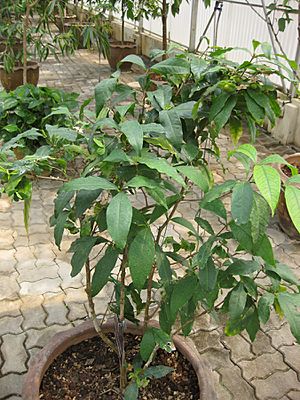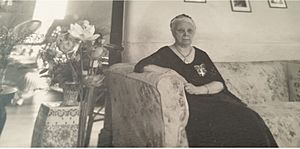Emily Collins (botanist) facts for kids
Elian Emily Collins (born Emily Pemberton on September 4, 1858 – died around 1945) was an amazing English botanist and naturalist. She was one of the first people to collect plant samples in Thailand. Emily Collins found many new plant species that scientists had never seen before. Because of her important work, several plants were named in her honor.
Contents
About Emily Collins
Her Early Life and Travels
Emily Collins was born in Myanmar (which was called Burma back then) on September 4, 1858. She later married David John Collins, who worked as a surveyor. In 1877, she moved with her husband to Thailand.
Collecting Plants for Science
Emily Collins was one of the first people to collect plant samples in Thailand. She gathered plants mainly in the areas of Chonburi (Si Racha) and Chanthaburi. She did this important work between 1902 and 1938.
She met Dr. Arthur Francis George Kerr in Si Racha in September 1911. He encouraged her to collect more plants. Emily often sent her plant samples to Dr. Kerr, who added them to his own collection. These samples are now kept at the Natural History Museum, London.
Emily also sent plant samples to other scientists and to the Royal Botanic Gardens, Kew. This is a very famous garden and research center in England.
She wrote letters to Professor William Grant Craib from Aberdeen University. He was writing a book about the plants of Thailand. Professor Craib saw Emily Collins as one of the two most important collectors. She provided many samples from the Si Racha area to the Royal Botanical Gardens. The other important collector was Dr. Kerr.
Emily also wrote to Sir Arthur William Hill, who was the Director of the Royal Botanic Gardens, Kew. Besides sending plant samples, she sent photos and information. She shared local names for plants and how people used them. She also sent samples to Trinity College, Dublin, through Sir David Prain.
Her plant samples are now stored in special collections called Herbaria all over the world. You can find them in Bangkok, Harvard University, the Natural History Museum, Kew, and other places. After Emily stopped collecting in 1938, very few scientists collected plants in that part of Thailand until the 1970s.
Emily Collins was also one of the first members of The Natural History Society of Siam. This group started on March 6, 1914. Later, it became part of the Siam Society. In January 1929, Emily helped release special fish called Gamusia into Thailand's waters. These fish eat mosquitoes, which helps control diseases.
Awards and Recognition
In 1938, Emily Collins received a special award called the Member of the Most Excellent Order of the British Empire (MBE). This was given to her in the King's Birthday Honours List for her great contributions.
Plants Named After Emily Collins
Many plant species have "collinsae" or "collinsiae" in their scientific names. This is a way to honor Emily Collins and her discoveries. Some of these plants include:
- Actephila collinsiae
- Ardisia collinsae
- Lagerstroemia collinsae
- Rivea collinsae
- Eugenia collinsae
- Stemona collinsiae
- Tarenna collinsae
- Mitrephora collinsae
- Zanthoxylum collinsae
- Argyreia collinsae
- Phyllanthus collinsiae
Her Later Life
Emily Collins continued to live in Thailand until her death. She passed away sometime after World War II, around 1945.
See also
 In Spanish: Emily Collins (botánica) para niños
In Spanish: Emily Collins (botánica) para niños



